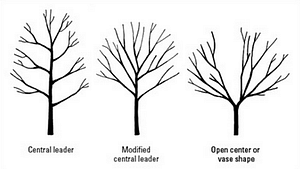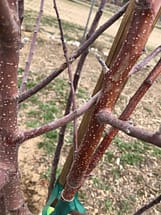Some people choose not to prune their fruit trees. If you do choose to do so the main benefit is easier harvesting. There are two main things to address when pruning fruit trees: pruning for structure, and pruning to remove potential problems.
Pruning For Structure
Structural pruning in fruit trees leads to 3 generally accepted systems: Central Leader, Modified Leader, and Open Center. I recommend using both the central leader and open center layouts for almost all fruit. Occasionally the modified leader can be necessary for very heavily branched fruit trees. I’ll focus on the Central Leader and Open Center methods.
Central Leader: This method allows for a strong central trunk and branches that grow horizontally off the trunk. This is great for apples and pears as they have heavy fruit.
Things to look for when pruning: Not having two branches near each other on the same side of the trunk. You’d ideally want a branch on the right, left, then back/front as you progress up the tree. This allows for balance of the tree.
Open Center: This is also known as the vase method. No central trunk is formed here. Instead you have several large branches the shoot out away from the center which allows for and airy center with plenty of space for sunlight to penetrate. This is recommended for: quinces, crabapples, plums, cherries, peaches, nectarines, and apricots.
Things to look for when pruning: Making sure there is an even distribution so that the tree isn’t too heavy on one side. Keep any vertical growing branches short as they are very vigorous.
Pruning To Prevent Problems
The next major reason to prune is to remove dead, diseased, suckers, weak, or overly strong branches. Below I have a series of photos with branches that are either crossing, rubbing each other, growing towards the center, or diseased. Other branches that are growing directly vertical (also known as ‘water sprouts’) or with a very acute angle from the branch it emerges from (less than 45°) need to be removed as well.
If you choose not to prune your fruit trees regularly, dead and diseased branches should still be removed immediately. Suckers as well should be removed from the graft union at the bottom of the tree.
If you have more questions about pruning fruit trees leave a comment below and I’d love to help coach you through the pruning process.










Awesome post! Keep up the great work! 🙂
Awesome post! Keep up the great work! 🙂
Great content! Super high-quality! Keep it up! 🙂
I’m commenting to make you understand what a beneficial experience our child experienced reading your site. She noticed a good number of pieces, most notably how it is like to have an ideal coaching nature to let the others easily grasp selected extremely tough matters. You really surpassed our expectations. I appreciate you for showing these useful, trusted, explanatory and cool guidance on the topic to Lizeth.
Glad we were able to help!
Say, you got a nice blog post.Thanks Again.
Hey very nice blog!
Hey there just wanted to give you a quick heads up. The text in your content seem to be running off the
screen in Firefox. I’m not sure if this is a format issue
or something to do with internet browser compatibility but I figured I’d post to
let you know. The design and style look great though!
Hope you get the issue resolved soon. Many thanks
Thanks for the heads up, much appreciated. Thanks for reading!